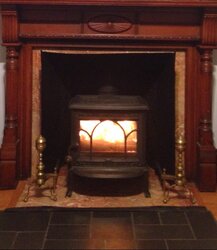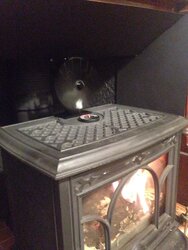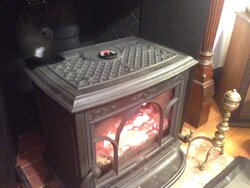Hi all,
Just got the Jotul F100 up and running and am totally enjoying it, but I think there may be ways to get more heat into the stove room and therefore other parts of the house. My stove is sitting on the hearth with just the rear legs in the firebox (see pic below) and has heat shields on three sides. I have about 14 inches of depth in the firebox behind the stove and that is where a lot of heat seems to be getting trapped (it's warm and toasty when I put my hand back there!). I have an insulated blockoff plate, but the company that did the liner install didn't seal that off completely with high temp silicone (it's just kind of wedged up there), so sealing that may help, but I want to wait to do that until after stove inspection in case inspector wants to take a look, and I'm not sure that's the main issue. I have a ceiling fan in the stove room that I'm running in reverse, which helps and I put a box fan facing the stove, which also helps, but I wonder if there are other better solutions. The last two nights I've gotten the stove room up to 71 degrees and would like to get it warmer (and think I can). Some things I'm thinking about are getting an ecofan and perhaps even place it blowing behind the stove into the firebox to blow air out of there. I seen some people here say these don't do much, but these two seem to get some good reviews:
https://www.amazon.com/dp/B0762PR6XT/?tag=hearthamazon-20
https://www.amazon.com/dp/B012U9E3JW/?tag=hearthamazon-20
I also wonder if there's some sort of a blower I could do, though I prefer the idea of no electricity like with the ecofans.
Thoughts?
[ATTACHl]221133[/ATTACH]
Just got the Jotul F100 up and running and am totally enjoying it, but I think there may be ways to get more heat into the stove room and therefore other parts of the house. My stove is sitting on the hearth with just the rear legs in the firebox (see pic below) and has heat shields on three sides. I have about 14 inches of depth in the firebox behind the stove and that is where a lot of heat seems to be getting trapped (it's warm and toasty when I put my hand back there!). I have an insulated blockoff plate, but the company that did the liner install didn't seal that off completely with high temp silicone (it's just kind of wedged up there), so sealing that may help, but I want to wait to do that until after stove inspection in case inspector wants to take a look, and I'm not sure that's the main issue. I have a ceiling fan in the stove room that I'm running in reverse, which helps and I put a box fan facing the stove, which also helps, but I wonder if there are other better solutions. The last two nights I've gotten the stove room up to 71 degrees and would like to get it warmer (and think I can). Some things I'm thinking about are getting an ecofan and perhaps even place it blowing behind the stove into the firebox to blow air out of there. I seen some people here say these don't do much, but these two seem to get some good reviews:
https://www.amazon.com/dp/B0762PR6XT/?tag=hearthamazon-20
https://www.amazon.com/dp/B012U9E3JW/?tag=hearthamazon-20
I also wonder if there's some sort of a blower I could do, though I prefer the idea of no electricity like with the ecofans.
Thoughts?
[ATTACHl]221133[/ATTACH]
Attachments
Last edited by a moderator:




